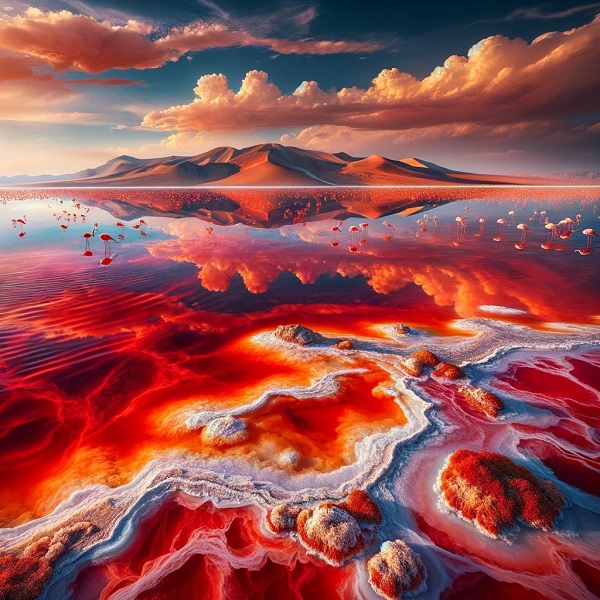
Unfolding the Mysteries of Lake Natron
Kay
- 0
If you’re a fan of natural wonders, you should make your way to Lake Natron in northeastern Tanzania, where nature operates on a whole different level than anywhere I’ve visited in Africa. Like nowhere else, Lake Natron embodies the enormity and numinous workings of the world. To try to explain it, though, you’d have to start somewhere.
Geographical Location
Where is Lake Natron?
Lake Natron sits just north of Tanzania’s border with Kenya. It’s located in the East African Rift Valley, a region known for its mountains, volcanoes and rich geological activity. Lake Natron is small, rarely more than 3 meters deep. Strangely, it’s this unusual lake that stands out above all the others.
Accessibility
That pink lake doesn’t get a lot of visitors, and that’s partly the reason why I wanted to go to Lake Natron. Getting there isn’t easy; in fact, that’s part of the allure. You need to fly somewhere, maybe Arusha, a city in Tanzania, and then drive a long, long way across rough terrain. Lake Natron is beautiful too, rising vertiginously from endless savannah, the rugged African landscape falling away sharply on every side. There are elephants, birds, baboons along the route to the lake.
Unique Characteristics
The Alkaline Waters
One of the lake’s defining features is its water chemistry: the light blue water of Lake Natron has pH values between 9 and 10.5, making it one of the most alkaline bodies of water in the world. The water’s high pH is a result of sodium carbonate and other minerals leaching out of the volcanic bedrock surrounding the lake. The water is so caustic that skin and eyes exposed to it often sustained serious burns. Paradoxically, the harsh environment of Lake Natron is what makes it a breeding ground for life Flamingos’ Paradise
Environmental inhospitality notwithstanding, the alkaline waters of Lake Natron are a suitable nursery for a wide cluster of endemic migratory and nonmigratory fish species and some of Africa’s heaviest concentrations of Lesser Flamingos, Gentianidas minor (Phoeniconaias minor). The flamingos feed on a healthy bloom of cyanobacteria, the abundance of which is induced by the highly alkaline and warm waters. Every year, tens of thousands flamingos perform an impressive airlift to and from Lake Natron, and turn the windswept, alkaline terrain pink as a scarlet sunbird’s beak. Few other spots in the world give rise to so many of these beautiful birds, and the place is therefore an ecological gem.
Ecological Importance
Biodiversity
The extreme conditions at Lake Natron support a distinct set of ecosystems, which (along with and some remarkable fishes that have adapted to the lake’s high salinity and alkalinity. These forms represent a vibrant diversity of indigenous, ‘wild’ life forms, many playing ecological roles in the region’s food web: each has a place in the biological hierarchy.
Conservation Efforts
Efforts to save this environmentally important site have included a raft of conservation projects aimed at keeping pollution and habitat destruction at bay. Organizations and local communities work closely to monitor water quality, regulate tourism through Tanzania’s open access policy, protect areas from visitors or provide people with alternative places to bathe. Education programmes target tourists and local residents alike.
Historical Significance
Ancient Human Footprints
Lake Natron also holds historic tracks. In 2006, researchers found fossilized footprints of ancient humans in the lake’s sediment. Researchers estimated the footprints date back at least 19,000 years. 12,000 years ago, animals in the Rift Valley such as elephants (shown), hippos, giraffes, zebras, and antelopes began migrating according to the seasons.
Local Legends and Myths
This eerie beauty has led to a plethora of local myths and legends. Many people tell tales of witches, spirits and other natural wonders around Lake Natron. These tales add a thick, enchanted layer to the lake and its surroundings. Here nature isn’t just a site of wonders, but also of beauty and folklore.
Tourism and Activities
Best Time to Visit
Lake Natron can be visited year-round, but the seasons play an important role for wildlife-watching, as some species, particularly the birds, migrate. The best time to visit is during the dry season, which lasts from June to October. This is the most predictable season with regard to the rainfalls, and the wildlife, including the flamingos, seems to be more concentrated around the lake. The dry season is also the best time for photography and outdoor activities.
Activities to Enjoy
Bird Watching
For bird watchers, it really is paradise: there are millions of flamingos here, and many more bird species. Bring your binoculars and a decent camera, and take your pick.
Nature Walks and Hikes
One of the best ways of enjoying all that is both on and around Lake Natron is to get out on foot exploring. Guided walks are a good introduction to the flora and fauna (such as huge hare-lipped generas nala), as well as to how the waters of Lake Natron were brought back into the rift valley, as a result of the rifting forces. Hikes are also a highly recommended experience of this geological phenomenon that reveals the awesome power of the earth’s forces in Tanzania.
Photography
Lake Natron is a paradise for photographers: the red‐orange waters and white salt crusts mean that every frame is a postcard picture, especially at sunrise and sunset when the light is at its most ethereal. Those pink flamingos at vivid sunset are something to be remembered! Lorenzo Vassallo Edited extract from Rodrigo’s Tropic of Capricorn (2020) by arrangement with Meridiano Publishers, Portugal. Top image provided by the author.
Challenges and Threats
Environmental Concerns
Indeed, even with its beauty, Lake Natron faces several environmental threats as a result of climate change as well as pollution and other human factors that are disturbing the delicate balance of its ecosystem. Rising temperatures and changing rainfall patterns could easily lead to variations in weathering patterns and other changes in water levels and salinity, which would disrupt the balance of life on and around the lake.
Human Impact
Likewise, uncontrolled agriculture, mining and tourism can have a deleterious influence. Left uncontrolled, tourism could negatively affect the habitats and industrial activities might introduce toxins into the lake. Thus, sustainable practices are imperative in order to preserve Lake Natron for its endemic fauna.
Future Prospects
Sustainable Tourism
Some ways we can do this is to reduce the number of tourists, improve the quality of eco-friendly accommodation, and further educate tourists on the powerful relationship between consumption and conservation. This way we can be sure that we reduce our footprint, allowing others from the future to experience the incredible spectacle of Lake Natron.
Conservation Initiatives
Lake Natron and its unique inhabitants remain under threat from development around the lake, but a handful of conservation efforts are ongoing to protect the site. These include habitat restoration, research and education projects, and work with local communities, and donations or ethical tourism can make a real difference to these efforts to preserve this extraordinary place.
Conclusion
There are surprises and contrasts everywhere. Lake Natron is a place of extremes. But the extremes create an oasis for some of the world’s most resilient species, a relic of both a geologic and human past, and it is these layers of the lake that add richness and wonder. Visiting Lake Natron turns a trip into an adventure in one of the strangest gifts from Earth, and it may change our perceptions about a part of the world that is more diverse and complex than we realize. Pack your bags. Get ready for the adventure. Go see Lake Natron.
FAQs
Is it safe to swim in Lake Natron?
The most direct reply would be ‘No, because the alkalinity of the water would burn your skin and eyes, and you would certainly die.
What is the best way to get to Lake Natron?
Getting to Lake Natron is best done by driving out of the city of Arusha in Tanzania and then joining an organised tour group or a jeep safari.
Why do flamingos flock to Lake Natron?
Evolutionary engineers must include the tempting promise to flamingos of a safe birthing ground and a feast of the cyanobacteria that thrive in the superalkaline waters.
Are there accommodations near Lake Natron?
Yes, I think there are lodges and campsites around lake Natron there are tourist visitors where they can visit the lake and the lake surroundings and they can do activities incredible.
What should I bring when visiting Lake Natron?
When travelling to Lake Natron, it is advisable to bring water, sun screen, a hat, good walking shoes, binoculars for bird-watching, as well as a good camera to capture the natural beauty of the surroundings.
Samsung Galaxy S21 LG V60 ThinQ iPhone 12 Pro Max Samsung Galaxy Z Fold2 Samsung Galaxy S21 iPhone 12 Pro Max LG V60 ThinQ Samsung Galaxy Z Fold2 Samsung Galaxy S21


